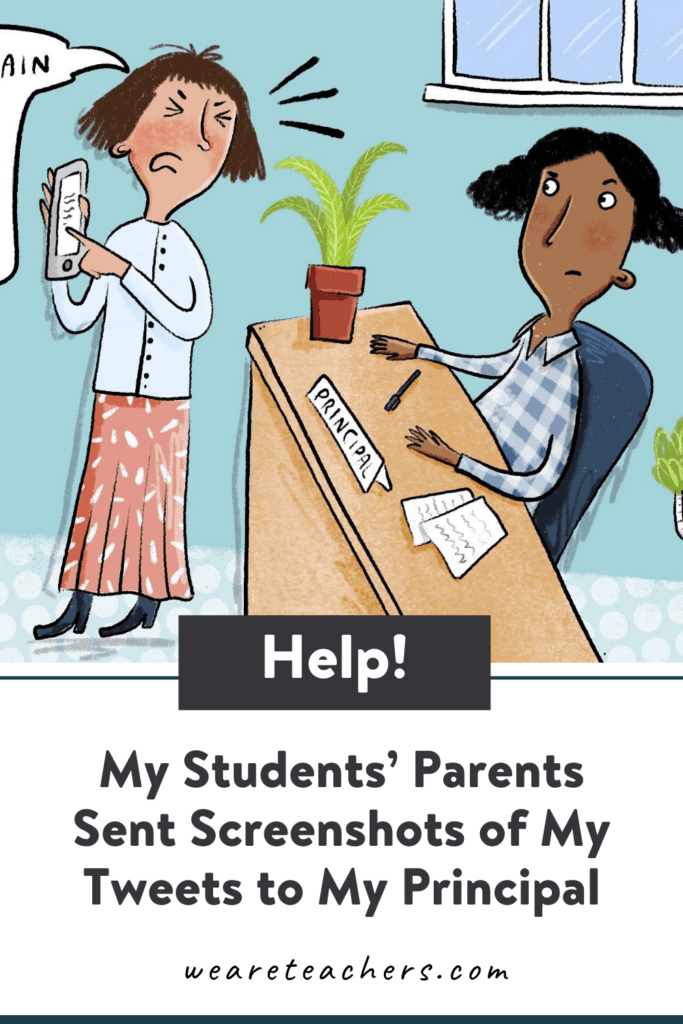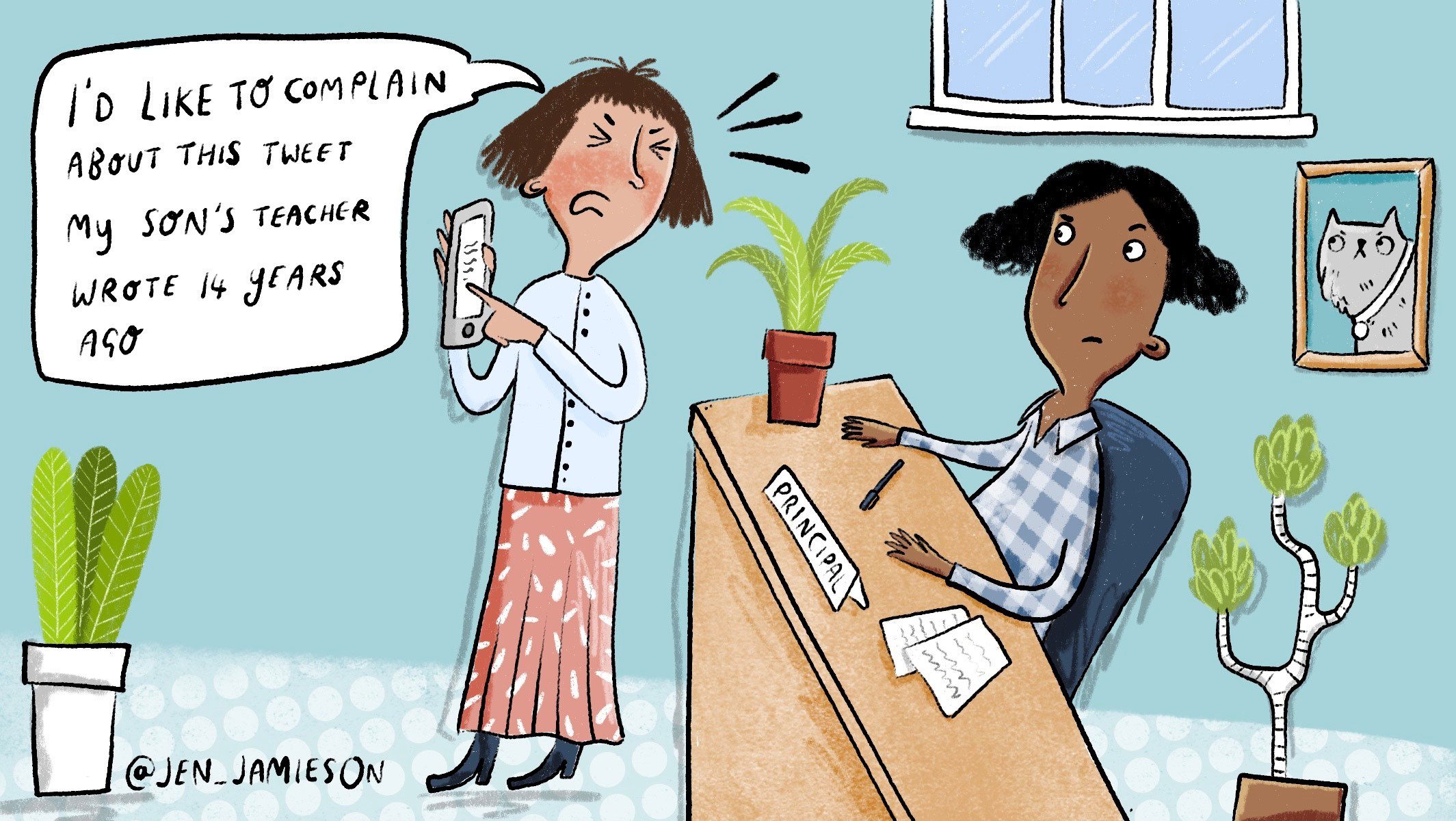Dear WeAreTeachers:
I have taught fifth grade in a rural community for years. I am also active on teacher Twitter, where I participate in a wide range of conversations on everything from literacy to classroom management to PD. I’ve always had a good relationship with my students’ parents, but this year I feel like I have a target on my back. I was shocked when my principal called me into his office to share that parents had sent him a series of screenshots of tweets I made several years ago about the importance of having a diverse classroom library. My principal supports me, and I stand by my opinions, but I feel like these folks are going out of their way to impugn my character and my work. How can I move past this? —All Are Welcome
Dear A.A.W.,
It’s so unsettling to feel undermined and attacked. Teaching is hard enough, but to be working under threatening conditions can trigger the fight, flight, freeze reactions and make it monumentally challenging to focus. There has been a swell of reactivity, fear, and political divisiveness around diversity education from parents all over the country. Please know the WeAreTeachers community is rallying behind you in the spirit of equity and inclusion. I say this is an opportunity to hold the line and push back on marginalization.
Thankfully, your administrator is backing you up. What a relief! Hopefully, your principal will help facilitate a meeting with the families. It’s challenging and necessary to address the parents who are trying to intimidate you. Take the time to meet with your principal and discuss why diversity and representation in texts matter in classroom spaces. Look over your site and district messaging related to inclusion and culturally-responsive practices. Sharpen your ideas together so that you can articulate the importance of diverse texts. Then, you will be ready to set up a meeting with the families and your principal.
I’m imagining a welcoming library in your classroom that sends the message that all are welcome here. A space brimming with diverse authors, characters, places, and issues that make students relate, explore identity, and deepen compassion as they learn about others. Emily Style came up with the concept of books as mirrors and windows. Mirrors represent different aspects of students’ lives, including family, language, culture, gender, immigration status, ethnicity, and more. Books that serve as mirrors affirm and validate students’ lived experiences. Diverse text selections send the message that your students’ perspectives are valued and that each of your students has funds of knowledge on which to build.
Books that act as windows help students get curious about lives different from their own. Reading books with characters who are different and topics that are new helps to expand new interests. Though at first we might read and notice differences, windows can also promote an appreciation for the common humanity in all of us.
Thank you for your advocacy to create a classroom culture where every single child feels welcome, seen, and heard every single day. All the parents I know want that for their own children. Protect your powerful read-aloud time and dig into some inspiring, juicy books and discussions to help make our world a little more just—one book at a time.
Dear WeAreTeachers:
I just can’t believe we are still going to have state standardized tests in this current reality with COVID. Not only is about one-third of my class not in school at the moment due to COVID-related issues, but the past few years of instruction have really been compromised. Online Zoom instruction for my third graders was SO hard and mostly ineffective. The kids are way behind in comparison to other years. Most teachers dread testing and feel like the standardized tests don’t really represent what students know. Let’s come up with something better! Any advice on how to get some momentum started with shifting from standardized testing? —Standardized Testing Stinks
Dear S.T.S.,
You are not alone with your frustration about moving forward with standardized testing in the context of this enduring global pandemic. With major absence rates due to exposure and positive COVID results, there is a major lack of continuity in teaching and learning. Imagine what it will be like to do all the make-up testing due to absences! And it’s worrying teachers. How will the assessment data be valuable? Many teachers don’t want to put their students through the grind and displace instructional time that has already been so compromised.
San Diego educator Corinne DeShon expressed these concerns about testing and her third-grade students: “I’m feeling overwhelmed and slightly disappointed. I know our students have had the most tumultuous last couple of years, and it’s expected they will be a little behind (some very behind). But testing them with assessments that are meant for students who’ve had consistency in their education has felt unfair. There is a lot of pressure right now for teachers to make up the gap, but it’s a daunting task when both students and teachers are constantly coming in and out of the classroom due to the pandemic.”
How did we get where we are with so much testing? The College Entrance Exams became common in 1901 and measured knowledge of about nine different content areas. And then, over time, quantifying intelligence and aptitude became more and more ingrained. By 2001, the No Child Left Behind legislation expanded state-mandated standardized testing as a way to assess school performance. It’s a big business, expensive, time-consuming, and sometimes we are left scratching our heads if standardized testing is worth it—especially now.
No one is suggesting that assessment is useless. On the contrary, teachers focus on gathering evidence of student learning and measuring the impact of their teaching every single day, every single lesson. Northwest Evaluation Association describes how integral formative assessment is to student learning. “Formative assessment focuses on two main things: teachers and students gathering accurate information in the moment, and teachers using that information to quickly adapt instruction. Ongoing formative assessment practice strategically transforms both students and teachers into decision-based data collectors.” As you navigate being a responsive teacher, formative assessment is immediate and high leverage.
The emotional well-being of our students needs to take center stage. Teachers all over the nation are prioritizing social-emotional learning competencies: self-awareness, self-management, social awareness, relationship skills, and responsible decision making. Our kids are experiencing trauma, heaps of uncertainty, and for some students, testing causes a great deal of anxiety. “Test anxiety is a psychological condition in which people experience extreme distress and anxiety in testing situations. While many people experience some degree of stress and anxiety before and during exams, test anxiety can actually impair learning and hurt test performance.”
So, your momentum starts with conversations with grade levels and instructional leadership teams. One conversation at a time is where we all start.
Dear WeAreTeachers:
My husband and I teach high school in a smallish area. Our options for babysitters are pretty limited, and we’ve been considering hiring some of our current or former students to work for us as babysitters. We would, of course, pay them a fair wage. The going rate in our town is $20 per hour. Whether they agree to this or not would have no bearing on their work or grades in school. Still, I have some misgivings, as does my husband. Can we take advantage of this source of teenagers in need of spending money, or would this blur too many lines? —Desperately In Need Of A Date Night
Dear D.I.N.O.A.D.N.,
Thanks for writing in about this real-life dilemma. I’m sure some people will have strong opinions and firm boundaries around mixing personal and professional lives. I lean into the blurred lines. You live in a smaller town and want to have a nice break with your partner and need someone you can trust to help. It sounds like a win-win to me.
My own daughters have been babysitters for their teachers in the past, and it was great. They were able to learn about hard work, safety, responsibility, building trust, and having solid communication. My daughters felt super valued with the compensation, too. I was relieved they were in spaces where they were known and valued and treated with respect. The teacher parents really knew my daughters. They often expressed gratitude about having a sense of ease leaving their children with my kids.
Have explicit conversations with the students to help them navigate situations that might be sticky for them. Consider saying, “I’m looking for a babysitter who is responsible, caring, and a good communicator. I think you’d be a great candidate. Let me know if you would like to talk about taking care of my children from time to time. Let’s meet at a park so you can meet the kids and see how it feels. The pay is $20 per hour. Let me know if you’d like to talk more about this possibility. No pressure!” If the babysitting does work out with your students, check in every once in a while to see if they need any support with issues that are coming up.
I do recommend trying to find former students versus asking someone you are currently teaching. This will lessen feelings of competitiveness and favoritism between your students. Wishing you all the best as you find a good fit for you and your family. Finally, enjoy the much-needed freedom and fresh experiences to come!
Want more advice column? Visit our Ask WeAreTeachers hub.
Dear WeAreTeachers:
I need some help! Last year, I did a bunch of trainings, covered classes, and ran an after-school club. We’re supposed to get paid for these types of things, and apparently, they used to do it with no problem (this is only my second year). By my count, the school owes me almost $2,000, but all of a sudden, they’re saying they don’t have the money. I am in contact with the union, but nothing is happening, and I don’t know what to do now. Any advice on how to handle this really frustrating situation?
Illustration: Jennifer Jamieson


